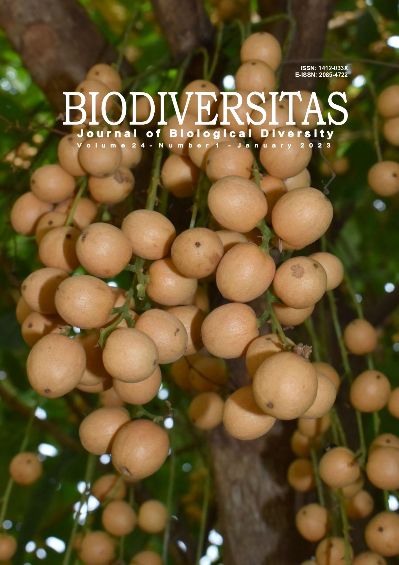The evidence of cloaca display as an indicator to validate breeding behavior during the matchmaking phase on local Indonesia female White-rumped Shama (Copsychus malabaricus)
##plugins.themes.bootstrap3.article.main##
Abstract
Abstract. Putranto HD, Nurmeilliasari, Harahap AS, Brata B, Sutriyono, Yumiati Y. 2023. The evidence of cloaca display as an indicator to validate breeding behavior during the matchmaking phase on local Indonesia female White-rumped Shama (Copsychus malabaricus). Biodiversitas 24: 486-491. White-rumped Shama bird, which Indonesian bird lovers call the Murai Batu bird (Copsychus malabaricus), has been a favorite bird for almost a decade. This bird is well-known among bird keepers for its colors and male singing voices. Generally, we recognize some biological behaviors that are trusted as avian behaviors. However, some specific behaviors in wild and domesticated birds are still not detected and unclear. The objective of this study was to validate and analyze the scientific evidence, frequency, and duration of cloaca display appearance as indicators of the female White-rumped Shama birds breeding behavior during the matchmaking phase. By animal focal sampling method, 18 sexually mature females of local White-rumped Shama captivated and observed by the research peer team were observed intensively for cloaca display activity during 22 days of matchmaking observation duration. Those 18 female samples were treated for matchmaking with another 8 males. For the cloaca display frequency and duration parameter, a time sampling method was used by dividing a total of 6 hours of daily behavior observation into 3 hours of observation duration, 2 times a day with 6 hours of distance between one observation and to next observation. Daily behavior observation conducted between 06.00 am to 09.00 am continued from 03.00 pm to 06.00 pm. Cloaca display frequency was counted as how often a female shows a cloaca exposure to her male matchmaking partner during the daily observation period. Then, a cloaca display duration was measured in the unit of seconds for each cloaca display behavior confirmed. Seventeen (17) female White-rumped Shama birds (94% samples) exhibited motion of cloaca display, with 21 motions of cloaca display behaviors confirmed. The earliest cloaca display behavior was confirmed on day 15 after matchmaking began, and the latest behavior was confirmed on day 22 after matchmaking began. These behaviors were seen on average of day 18.9±2.256 after matchmaking began. The shortest duration of cloaca display behavior lasted for 1.62 seconds, and the longest lasted for 6.26 seconds, with an average duration of 4.37 seconds for each motion. The average daily confirmed cloaca display frequency among that female White-rumped Shama was 0.053 times in 22 days of matchmaking observation duration. Cloaca display motion is seen daily (21 days) during 22 days of observation conducted, and the relative frequency percentage of cloaca display behavior was 95.45%. There is no proven info about the breeding behavior of this bird, and based on our scientific results, we strongly believe cloaca display motion can be validated as the main indicator of Indonesia's local female White-rumped Shama birds' breeding behavior. It can be read from the relative frequency percentage of cloaca display motion of female White-rumped Shama, which is overtopped 95% or dominant motion in its breeding behavior.
##plugins.themes.bootstrap3.article.details##
Most read articles by the same author(s)
- HERI DWI PUTRANTO, JOHAN SETIANTO, URIP SANTOSO, WARNOTO WARNOTO, NURMELIASARI NURMELIASARI, AHMAD ZUENI, Estradiol-17β hormone concentration and follicles number in exotic Burgo chicken supplemented by Sauropus androgynus leaves extract , Biodiversitas Journal of Biological Diversity: Vol. 13 No. 1 (2012)
- HERI DWI PUTRANTO, GADING PUTRA HASIBUAN, YOSSIE YUMIATI, JOHAN SETIANTO, BIENG BRATA, NOVITRI KURNIATI, FITRIAN FAJAR HAKIKI, The estimation of dynamical distribution of domesticated Burgo chicken population in Bengkulu coastal area, Indonesia , Biodiversitas Journal of Biological Diversity: Vol. 18 No. 2 (2017)
- HERI DWI PUTRANTO, BIENG BRATA, YOSSIE YUMIATI, Ex-situ population of White-rumped Shama (Copsychus malabaricus): studies of density, distribution and bird keepers in Bengkulu, Sumatra , Biodiversitas Journal of Biological Diversity: Vol. 21 No. 3 (2020)
- JOHAN SETIANTO, BASYARUDIN ZAIN, SUTRIYONO SUTRIYONO, HARDI PRAKOSO, Domestication of red jungle fowl: A case study of the red jungle fowl chicks procurement by the communities in Central Bengkulu, Indonesia , Biodiversitas Journal of Biological Diversity: Vol. 18 No. 1 (2017)
- LILISTI, ZAMDIAL , DEDE HARTONO, BIENG BRATA, MARULAK SIMARMATA, The structure and composition of macrozoobenthos community in varying water qualities in Kalibaru Waters, Bengkulu, Indonesia , Biodiversitas Journal of Biological Diversity: Vol. 22 No. 1 (2021)
- HERI DWI PUTRANTO, A non-invasive identification of hormone metabolites, gonadal event and reproductive status of captive female tigers , Biodiversitas Journal of Biological Diversity: Vol. 12 No. 3 (2011)
- JOHAN SETIANTO, SUTRIYONO SUTRIYONO, HARDI PRAKOSO, BASYARUDDIN ZAIN, RIFKY ADWIYANSYAH, AMIR HUSAINI KARIM AMRULLAH, Short Communication: Phenotypic diversity of male Burgo chicken from Bengkulu, Indonesia , Biodiversitas Journal of Biological Diversity: Vol. 20 No. 2 (2019)
- HERI DWI PUTRANTO, EDI SOETRISNO, NURMEILIASARI NURMEILIASARI, AHMAD ZUENI, BERRY GIBSON, Recognition of seasonal effect on captive Sumatran Sambar deer reproductive cyclicity and sexual behaviors , Biodiversitas Journal of Biological Diversity: Vol. 11 No. 4 (2010)

